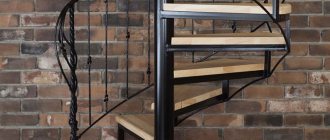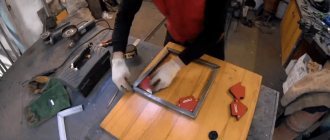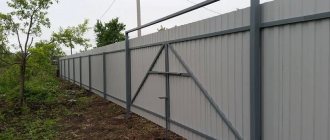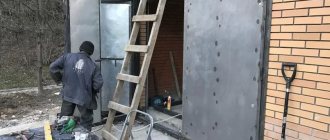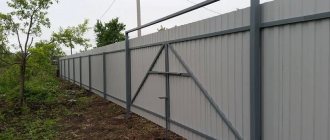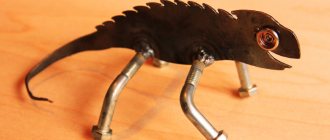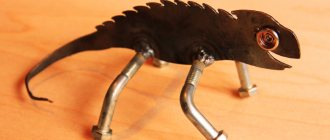Another welding option is from a corner. But to ensure the rigidity of the stairs, a large corner will be required, which means a significant waste of metal. You can use two small corners, but then they need to be welded to increase the profile of the bowstring.
No house is complete without a staircase. They are required to enter the house, to the second floor, attic or attic. Most people choose metal stairs. This is due to the advantages of the metal, its strength, durability, and the ability to give it any shape.
In addition to stationary ones, a mobile one is often required; for housework and gardening, an extension ladder or stepladder is always needed. Welding metal stairs is the best option.
Metal frame for interior stairs.
Do-it-yourself metal staircase: is it needed at all?
When talking about metal stairs, we can mean two types of structures: those made entirely of metal and stairs with metal frames. Both of them can be done on your own. What is the difference and how to choose the best option? How to weld a ladder and what is needed for this?
Stairs on metal frames are an excellent interior solution. They have a modern look, look very stylish, are quite durable and reliable, but are often more expensive compared to classic wooden ones. Only the frame of such stairs is made of metal - bowstrings or stringers. The handrail of the fence and steps are made of wood, and the vertical supports of the fence (balustrade) are optional; they can be either wooden or metal.
Metal frame for interior stairs.
But we will dwell in more detail on how to weld a ladder entirely from metal yourself. Such staircases can be used as interior ones, but it is very important to understand that metal is a “cold” material; unlike wood, it will rather bring a certain indifference and detachment into the house, helping little to create coziness. Keep this in mind if you are going to make a metal staircase to go up to the second floor in your living space.
Another thing is street stairs made of metal. They look truly impressive. But this is not the most important thing - no other type of stairs is simply suitable for outdoor use, since only steel can withstand unfavorable environmental conditions for many decades - rain, snow, low temperatures, etc. You can weld a metal staircase for the street at home conditions, and you will get a moderately expensive and fairly reliable design.
Street staircase made of metal.
Finally, another advantage of metal stairs is their highest strength, which cannot be compared even with high-quality wooden stairs.
So, let’s make a metal street staircase with our own hands!
Preparation of stringers begins with choosing a profile; the most common is a channel or an I-beam, but this is not the entire list of available configurations; the figure below shows various options.
General requirements
Stairs to the second floor, metal or wooden, are made with safety and ease of use in mind. The general requirements for structures are as follows:
- The width of the flight of stairs must be at least 90 centimeters. For the simultaneous passage of two people, the optimal values are from 120 to 150 cm.
- It is necessary to correctly calculate the angle of inclination of the march. The most optimal value is from 30 to 45 degrees. If you make the angle smaller, the entire structure will take up a lot of space; if it is larger, then moving up the stairs will be difficult and unsafe.
- For ease of movement, calculations are made of the height and depth of the steps. According to current practice, the first parameter should be within 15-20 cm. The depth of the steps is made according to the length of the foot - from 20 to 30 cm.
- Fences are not always used. But in the case of a family with children, you cannot do without them. According to general requirements, the distance between the staircase railing posts must be at least 12 cm.
- It is also necessary to make load calculations. The minimum weight that a steel structure must support is 100 kg. If there are larger members in the family, then the strength of the ladder should be appropriate.
Methods for manufacturing metal staircase structures
Types of metal stairs according to the manufacturing method are divided into three options:
- Forged
- Cast
- Welded
If you do not have blacksmithing skills, making forged metal stairs at home is a difficult task, the only option is to turn to professionals for help and order manufacturing and installation from them, or after making your calculations, order individual elements of the stairs from a blacksmith, and have the assembly and installation done yourself. Forged staircase structures are exclusive in production, since the forging process is still done by hand.
The material for manufacturing cast metal structures is cast iron; this manufacturing method is expensive and only practical on a production scale.
Welded metal stairs are much easier to manufacture compared to forged or cast ones; with the right desire, anyone can weld a staircase with their own hands at home, but this work also requires basic knowledge of welding.
(Click on image to enlarge)
By drawing a diagram of the design of the future staircase, a person makes his task easier in the process of installing the gangway.
Combinations.
A hand-made metal staircase is not only convenient. But also beautiful. Metal goes well with other materials. Finishing with glass, wood, stone, concrete adds beauty and elegance to the structure. Finishing materials are installed on any part of the stairs.
Fences are made of glass, perforated steel, and they are also decorated with various metal figures and carved works of art. Metal fences add rigidity to the structure, while the rest have only decorative value. Metal cutting for stairs is also an excellent solution.
Steps are also made from various materials. It is believed that metal stairs are in harmony with wooden products. It is not necessary to make the entire step out of wood. A comfortable wooden flooring is made. Concrete steps are also often used. This depends on the load-bearing capacity of the stairs to the second floor, since concrete is very heavy. In addition to concrete, porcelain stoneware is used, which also looks great in the interior.
The step is also made of corrugated iron.
Important. If the interfloor staircase is located on the street, it is often made entirely of metal. And home structures are finished with materials that are closer to the heart. A staircase with wooden steps is an excellent solution.
How to make a drawing of a metal staircase
Making a drawing of a metal staircase with your own hands is quite simple. To do this, you need to take measurements of the space in which the steps leading to the second floor will be located.
Required materials for measuring
In order to measure space, you should have the following accessories on hand:
- Tape measure with maximum length;
- Surface level meter;
- Chalk or a special felt-tip pen that can be used to make the necessary marks on the wall, floor and ceiling.
This is a minimum set of accessories that will help you carry out the measurement process efficiently and quickly.
Required materials for the drawing
To make the diagram as accurate and correct as possible, you should also prepare a number of stationery items. Namely:
- A sharpened pencil or black marker with a thin tip;
- A sheet of paper or whatman paper;
- Ruler;
- Compass.
You should draw the diagram carefully and carefully so that during the actual installation process you do not make errors that are difficult to correct.
What parameters need to be measured
In order not to make a mistake and correctly make a drawing with your own hands, you will need to make the following measurements:
- The height from the floor to the beginning of the second floor level at the selected angle of inclination.
- Distance from floor to steps. If you plan to install a solid structure, strengthening it on the floor, then this measurement can be omitted.
After taking measurements, you can transfer the recorded parameters onto a sheet of paper, forming a diagram of future gangways.
What nuances must be taken into account during the process?
When taking measurements, be sure to pay special attention to the following factors:
- Be sure to measure the height at the required angle;
- It is also worth considering that the height of the future gangway should be at the level of the beginning of the second floor, and not at the level of the ceiling of the first tier of the apartment;
- When installing metal stairs in your house, you should take into account that these structures weigh quite a lot. Therefore, it is necessary to strengthen the walls before starting work or simply make sure of their strength if the house was built recently.
Return to contents
If desired, you can make 2 metal structures in the house. The most important thing is to prepare everything you need and carry out the work as prescribed by the step-by-step instructions.
Metal corners
The most critical area of the degree is the outer leading edge. If it is wet or covered with ice, then there is a high probability of your foot slipping. Therefore, it is recommended to equip steps with metal corners, which are made from different alloys.
Purpose and types
- Iron profiled corner. An excellent option, wear-resistant, with an increased service life. The only negative is that untreated steel corrodes outdoors.
- Aluminum ones are not inferior in strength and durability to any other types. Today, manufacturers offer aluminum products coated with wood imitation embossing. Unfortunately, the decorative layer quickly becomes unusable under the influence of mechanical loads. Therefore, such corners take on an unpresentable appearance.
- Rubberized products. These corners have long proven themselves in public transport, on ships and airplanes, as a coating with excellent anti-slip properties. Their only drawback is their short service life. But it doesn’t matter, rubber products are inexpensive, replacing them is not a problem even with your own hands.
Installation of anti-slip corners
There are no difficulties here. Steel ones are attached by welding or screws to the front panel of the frame. Aluminum and brass are also attached to the front plate with screws or bolts. Rubber ones are glued with a special adhesive called rubber boots. In this case, vulcanization technologies are used, that is, using thermal energy.
How to make a metal staircase: installation
After the calculation of the staircase structure has been completed and the main home-made steel elements have been created, the first stage of installation must begin. First you need to strengthen the metal frame. It includes metal stringers and support posts. It is for these elements that the maximum load is calculated.
To construct steps, fillets made of pipes, angles or channels can be used.
It is also possible to attach directly to the bowstring. Then it is necessary to calculate the intervals for the location of fasteners and develop schematic drawings for stepped stringers.
Carrying out a design project for the stairs to the 2nd floor yourself or welding the frame of external models is not so difficult if you adhere to:
- Individual needs;
- GOST rules;
- SNiP rules.
Approximate data has been developed for almost all product types. A sketch, sample and project can be ordered from a specialized company in Cherepovets or another city; such services are relevant today. The main thing is not to forget about the contract.
As for the steepness of the climb, if children or elderly people live in the house, the recommended slope angle is 30 degrees. Material consumption will increase when designing a flatter staircase.
Instructions for making stairs
The process itself can be divided into several stages.
Installation of stringers. The load-bearing beams need to be firmly fixed, for which the channels are perfectly matched to the surfaces of the lower and second floors. If you use welding, ensure that the fit is accurate and that the weld is as strong as possible. If you prefer a bolted connection, check that there are no distortions.
Steps can be formed in different ways
- Making steps. The simplest option is to weld the frame from a corner. How you orient it depends on your design intentions. If you are going to make steps from wood or sheet metal, the corner is mounted with the shelves down. If you plan to pour concrete or lay ceramics, use the shelves up. The frames are prepared according to the number of steps and welded to the stringers according to pre-made markings. To strengthen the steps, gussets or additional supports are installed.
- Steps can also be built in a more complex way, by making fillies, that is, supports for the steps in the form of the letter G. You need 2 fillies for each element; the parts are welded to the stringers, connected by crossbars and supplemented with gussets. This method involves more difficult markings and an increase in the number of welding seams.
- When the structure is assembled, all elements in the places where welding work was carried out are cleaned with a grinding wheel. The burrs are removed and the seams are straightened. The finished frame is primed and, in most cases, painted.
- At the last stage, step platforms are mounted on the stairs, railings are installed and decorative elements are hung, if they are provided for in the sketch.
Please note: if the staircase structure is constructed at the stage of building a house, then its decor is postponed until the stage of general finishing work. And one more subtlety: if you are not sure that you will be able to correctly make all the necessary calculations, entrust them to specialists
Designing without constructing a structure will cost you much less than making mistakes in a drawing: you will have to redo too much, waste extra materials, effort and time. And the worst thing is that incorrect calculations can make the operation of the stairs unsafe
And one more subtlety: if you are not sure that you will be able to correctly make all the necessary calculations, entrust them to specialists. Designing without constructing a structure will cost you much less than making mistakes in a drawing: you will have to redo too much, waste extra materials, effort and time. And the worst thing is that incorrect calculations can make the operation of the stairs unsafe.
Convenient, reliable, beautiful
You can see how a metal staircase is installed here:
Sheathing installation
Before starting work, you should decide whether additional fasteners will be required. This may be required if there are turning steps.
Installation is carried out in two ways:
- The first involves laying steps on top of the corner, after which they are fastened in such a way that the corner remains under the board.
- The second method is based on fastening to the corners, which are welded to the channel. After that, two more corners are installed so that a frame is formed in which the steps are laid.
Stages of work:
Installation of steps on stairs
To prevent the formation of chips, you can round the edges of wooden tread blanks.
Before installing the stairs, it is necessary to strengthen the metal frame
Conditions of comfort and safety
To make a metal staircase comfortable and beautiful, you need to understand a few clear, indispensable rules.
- The depth of the tread, taking into account the overhang (but more on that later) should be at least 270 mm.
- The tread depth, taking into account the overhang, should be no more than 350 mm. Otherwise, on each tread you will have to take two steps up and the same number down.
- The riser height must be at least 150 mm. Otherwise, you will need to make more treads, which means you will make the structure heavier with your own hands.
- The height of the riser should be no more than 180 mm. Otherwise, every climb will be a test for you.
- The steps to the second floor will be very comfortable if each subsequent upper tread hangs 20-50 mm above the previous one. Optimal, of course, is 30 mm. This has been tested by many broken noses and broken heels.
- The tread width for stairs with one flight can be 800 mm. If you have an image in your head of two flights of stairs with an intermediate platform with flowers in pots or a simple stained glass window, then the distance from the wall to the railing should be at least one meter. If you plan to provide free movement up and down for numerous guests, then the tread width should be 1300 mm or more.
Careful observance of basic rules will ensure the appearance of comfortable and safe flights of stairs in your home. You, your family and many friends will enjoy using it.
How to make a metal staircase: outdoor design
A metal structure for outdoor use is quite simple to make. You just need to have a welding machine or other special equipment, with the help of which you can bring to life the most daring solutions. Metal structures are in many ways superior to wooden stairs; they are more reliable and durable. The steps of the stairs must be made of reinforcement with a gap.
Snow will not linger on the rods, and ice can be easily removed. It is not recommended to arrange sheets; such stairs will be slippery and dangerous.
The outer structure of a metal staircase is quite easy to make.
Steps and platforms can be made of corrugated steel. For the construction of a staircase structure, a channel must be used. It needs to be placed on its edge. We must also remember about the fence. It can be made of angle steel, 45 mm wide. It is best to connect all the components together using electric arc welding.
The staircase will be:
- Durable;
- Reliable;
- Durable.
If the channel is used as stringers, then it is necessary to weld fillets made of metal to it, which have brackets for fastening the steps.
We calculate the number of steps by dividing the rise of the flight of stairs by the desired rise of the step and taking the whole part. For example, the rise of a flight of stairs is 3.5 m, the desired step rise is 18 cm. 3.5/0.18=19.4444444. This means we will have a march with 19 steps, the rise of each step is 3.5/19 = 0.1842 = 18.42 cm.
Types of steps
The classification of metal steps is carried out according to different parameters. According to the material used:
- aluminum;
- made of stainless steel (GOST 5632-72);
- made of galvanized steel (GOST 14918-80),
- made of low-alloy structural steel (GOST 380-60).
Aluminum steps for stairs have a low specific weight, which makes it possible to save on load-bearing structures by using small profiles.
Aluminum steps are light, strong and durable, but relatively expensive
Stainless steel steps have a purely metallic color, which makes them stand out from the general line, and they are not subject to the negative effects of humidity. And this is an additional plus that manufacturers use in the manufacture of steps for staircases intended for wet rooms.
Stainless steel is suitable for use even in rooms with wet processes - swimming pools, saunas, baths, etc.
Galvanized steel performs well in outdoor conditions, as it is not afraid of precipitation.
Ladder made of galvanized steel
Structural steel is used in the construction of objects with high loads.
It should be noted that the attitude towards stainless steel steps is ambiguous. On the one hand – beauty, reliability and long-term operation. On the other hand, these are the most expensive models, not everyone can afford them.
Materials and tools required for work
To build an interfloor metal staircase, we will need the following tools and materials.
Tools:
Materials:
Carrying out work
Stages of work:
First of all, angles for attaching steps, that is, fillets, are made from corners.
Also, the fillies must be identical and must be exactly opposite each other. The fillies are made from a corner by cutting out a sample and joining the corners together.
The result is L-shaped nodes with the shelves down and inward. For our design, fourteen pairs of these nodes are needed, and in each pair, one support will be left and the second will be right. Then we weld the brackets to connect the steps and the horizontal crossbar between each pair of corners.
We also make the horizontal crossbar from a corner. The structure is strengthened with the help of gussets; we weld them from the bottom of the step towards each of the stringers.
We make markings along the edge of the square pipe from the profile and, according to the markings, weld the fillets to the edge of the stringer, attach the second stringer to the first stringer with fillets and transfer the markings.
We check the level and then weld the stringers with the lower end to the support platform. If the houses have a concrete foundation, then the support platform is installed in concrete. We attach the upper end to the support post; the support post is secured to the ceiling between the floors with steel anchors. Then the fillies need to be checked for level again.
If the staircase is made near a wall, then to add rigidity to the structure, one stringer is welded to brackets that are fixed to the wall.
The finishing work consists of welding the steps to the fillets; you can also secure them with bolts, but in this case you need to cover the steps with wood. The steps can also be installed on wooden steps using screw connections.
Frame type
Having decided on the type and shape of the staircase, we move on to the stage of choosing the structure on which this staircase will be built. For each type of staircase, the following frames are distinguished:
- On the stringer.
- On the bowstring.
- On pain.
- Console.
- Modular (prefabricated).
Let's analyze each of these frames for each type of staircase.
Kosour.
It is a supporting structure on which shelves for steps are provided at a certain pitch. Such frames, in turn, are classified according to the location of the stringer:
Two or more stringers along the width of the flight.
One central stringer.
Bowstring.
Stairs with a metal frame on a bowstring are in many ways similar to structures on a stringer. The difference lies in the way the steps are attached. If on a stringer the steps are laid on the frame as if on shelves, then in the bowstring structure the steps are fixed on the inner end of the supporting beam. The shape of the bowstring may even look like a string from the side. Otherwise, this frame is also classified according to the location of the bowstring. Below are options for stairs with strings located on both sides of the flight.
On pain.
In this case, the metal frame of the staircase also serves as a railing. The railing structure is rigidly fastened between the first and second floors. The steps are fastened on one side on balusters to the railings. On the other hand, the following options are possible:
Wall mounting. This fastening is possible provided that the walls are built of strong material that can withstand this load. In the case of a spiral staircase, the fastening goes to the central pillar.
Mounting on a stringer.
On the bowstring.
Spiral staircase on rails with load-bearing railings on both sides.
Console.
Probably the most unusual staircase frame. The principle is that the steps are fastened on one side, resulting in a feeling of lightness of the staircase.
There are three options for fastening the steps of such a ladder:
- At the stage of construction of the wall along which the staircase is located, it is necessary to lay the steps so that 1/3 of the step is in the wall.
- The second option is considered if the wall is made of insufficiently strong material or the thickness of this wall does not allow 1/3 of the step to be built into it. In this case, installation is carried out using a bowstring located on one side of the steps. After this, the bowstring can be walled up in the wall.
- Fastening with metal brackets. This method is also applicable provided that the walls are made of sufficiently strong material.
A cantilever spiral staircase as such can only be made in round rooms (towers), the fastening principle is similar.
Modular (prefabricated).
The prefabricated staircase frame is formed using individual blocks, which are assembled into the required shape. This kind of frame requires regular attention for the reason that all the connections are not welded, this over time can lead to the appearance of play in the connections. Repairing such a structure is much easier than its analogues; in case of wear or damage, a separate frame block is replaced.
This is interesting: Stairs in a house to the second floor, photos and design features (video)
Reinforcement technology for DWG step flight elements
For many decades, construction company specialists have been using the AutoCad program, which helps make calculations. It produces a drawing that can be saved in 2D and 3D format. This simplifies the preparation and construction of the stairs.
The program allows even a non-professional to calculate the reinforcement of flights of stairs and obtain an individual drawing. Calculation of complex screw structures with winder steps is only available to professionals - special knowledge is required.
The program calculates not only reinforcement, but also other parameters:
- The shape of the stairs. The classic outlines are rectangular, but sometimes the sides of the marches are non-parallel or curved. The platforms are also not always rectangular; any profiles can be used.
- Creation of platforms and turns. The total height of the staircase is set, the length of the flights is calculated based on the size of the tread, and platforms are created.
- Material. A parameter that is set to calculate weight and strength. The style is selected taking this into account.
Calculating a staircase and reinforcement frame is not an easy task. The program greatly reduces the time it takes to complete this work and carries out accurate calculations.


